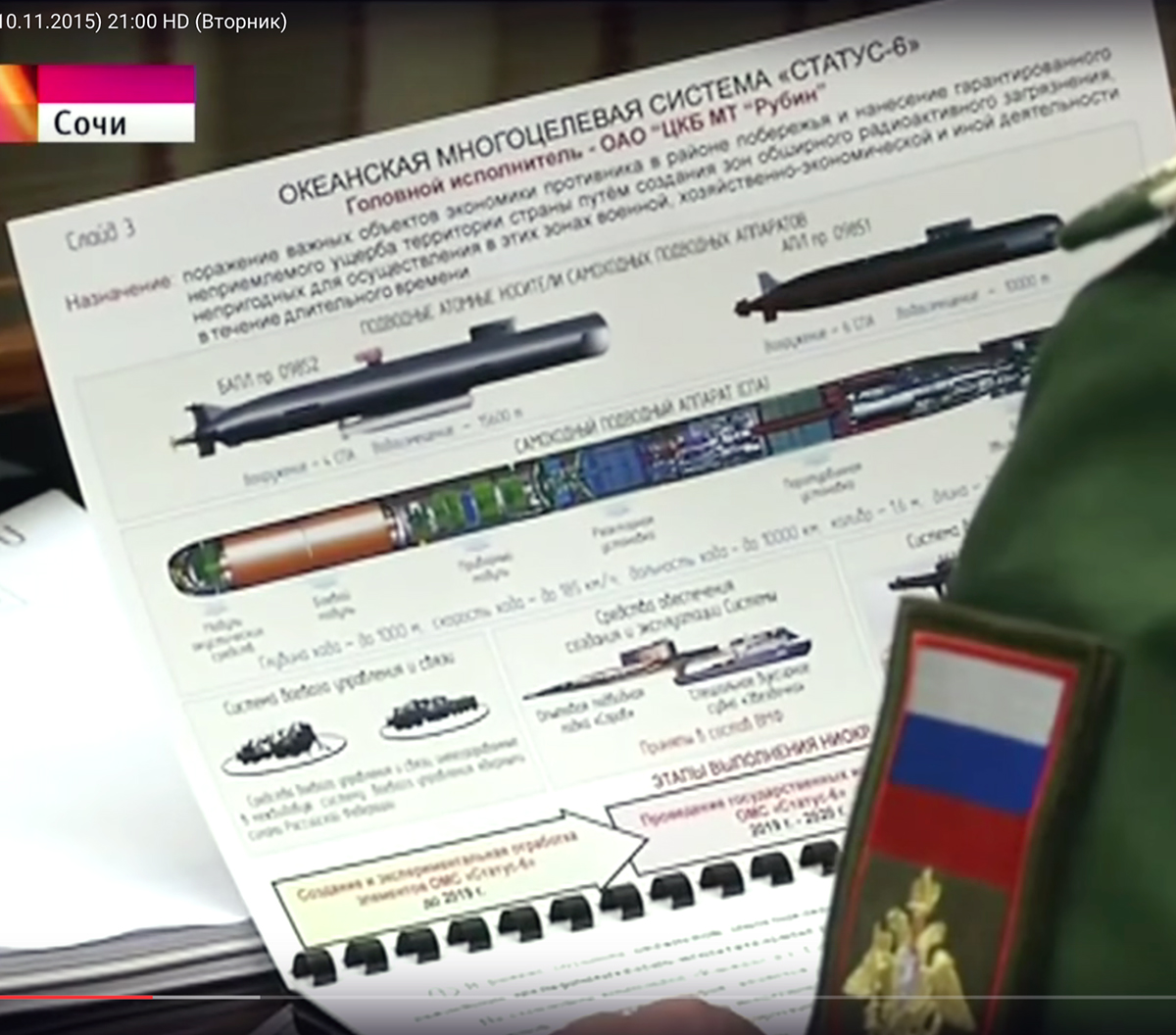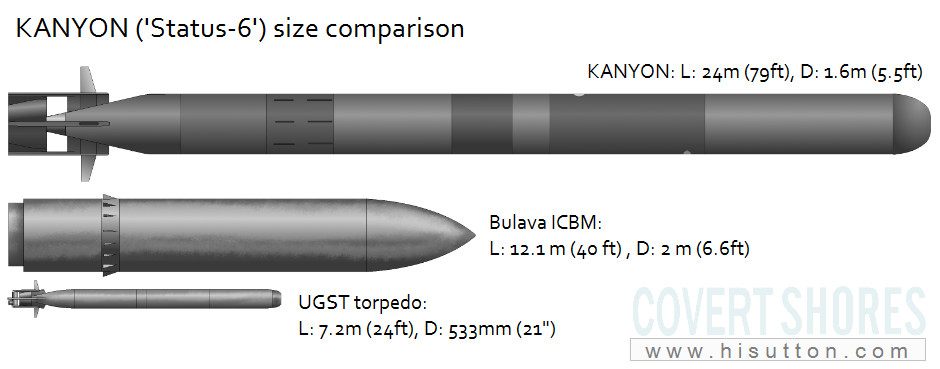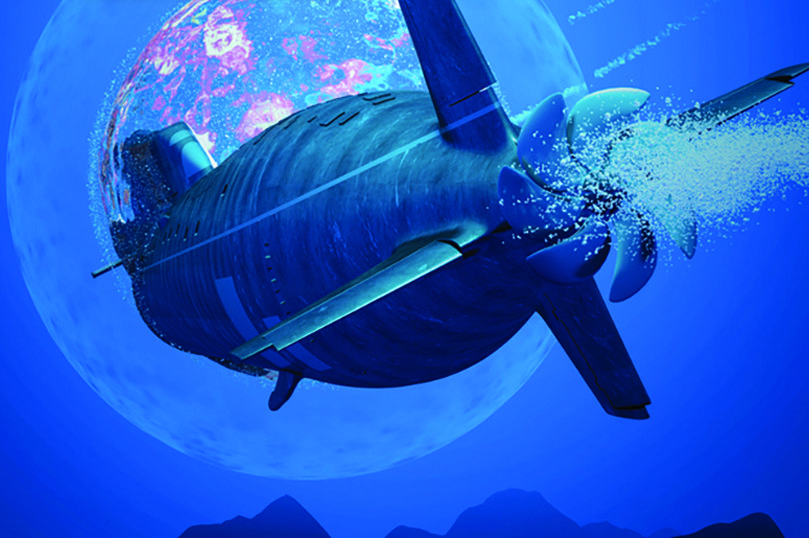 By Larry Bond & Chris Carlson
By Larry Bond & Chris Carlson
Things are going to get a little strange when your starting premise is “the world is ending.”
On March 1st, 2018, President Vladimir Putin addressed the Russian Federal Assembly. During the speech, he rattled not just one saber, but six, describing a range of new weapons that he claimed would make U.S. ballistic missile defenses “useless.” In addition to the RS-28 Sarmat heavy ICBM, and Kinzhal hypersonic land attack missile, he discussed the Status-6 nuclear2 torpedo.
Why the superscript? Because the Status-6 is a nuclear, nuclear torpedo. In other words, not only does it have a nuclear warhead, it’s nuclear-powered as well. This is not a hypothetical weapon system. The Russians are in the prototype design and testing phase that they plan to complete by 2020. They even have two submarines designed to carry it under construction.
Vladimir was not revealing anything new. Word of this system first appeared three years ago, in a Bill Gertz article on Project Kanyon published in the Washington Free Beacon on 8 September 2015. About two months later, a widely televised briefing to a group of senior officers of the Russian General Staff, attended by President Putin, included a remarkably clear image of a page in the briefing book (see below). While other shots with the briefing book had the pages blurred, this one was not. It’s clear the Russians wanted us to know about this, which is entirely sensible. Anyone who has watched Dr. Strangelove knows deterrence only works if the other side knows about it.

The Status-6 is a huge beast. Discard the image the word “torpedo” creates in your mind. A typical submarine-launched torpedo has a diameter of 533mm (21 inches) and is about 6-7 meters (20-23 feet) long. The Status-6 is 1.6 meters (5.2 feet) in diameter and 24 meters (79 feet) long. Look at the accompanying illustration from a popular website, Covert Shores, to see a comparison of the Status-6 with a conventional torpedo. Despite its size, the Status-6 is fast, travelling at 100 knots, and has a range of 5,400 nautical miles – this is why it is nuclear-powered. It would also operate at extreme depths, 1,000 meters, which makes it immune to all U.S. undersea weaponry.
The Status-6 is capable of and expected to carry a multi-megaton warhead. Reportedly, the warhead casing also includes a lot of cobalt, which in a nuclear detonation would become cobalt-60, a nasty radioactive isotope. Since the weapon would be detonated in the shallow water of a port or harbor, the amount of radioactive fallout would be immense. In sum, this is one honkin’ big dirty bomb.

Why would the Russians design such a fearsome device? Because the guiding principle of “Mutually Assured Destruction” isn’t as assured as the Russians would like. The working theory has been that as long as the U.S. and the USSR Russia would destroy each other, neither would use their ICBMs.
That’s worked for decades, but the situation is changing. If you like, use 1991 and Operation Desert Storm as a milestone, when a Patriot missile made the first combat kill of a tactical ballistic missile (an Iraqi Scud, 18 January 1991). The U.S. military now routinely fields anti-tactical ballistic missile capability in its ships and air defense systems – to include very unpopular, from a Russian point of view, land based sites in Romania and Poland. Oh, and let’s not forget it was the U.S. that walked away from the Anti-Ballistic Missile (ABM) Treaty in 2002 and now has Ground-Based Midcourse Defense sites in Alaska and California. And while the ground-based interceptors don’t have a great hit record right now, it’s likely that improving technology could allow the U.S. to shoot down large numbers of Russian intercontinental ballistic missiles (ICBMs).
From the Russian perspective, this is a Bad Thing. If the Russian response to a U.S. nuclear first strike can be blunted, then the Americans might launch a sneak attack. In Defensespeak, improving ABM technology is “destabilizing.” It increases the risk of nuclear attack.
Now, the Russians are also improving their own air defense systems, and that includes some that have an ABM-capability, but this isn’t about what is, but what could be. Neither side can shoot down large numbers of ICBMs right now, but what if the U.S. could? You gotta plan for the worst case.
While it is conceivable that the U.S. might be able to field an ABM system that could destroy a lot Russian ICBMs, there is no known technology or stuff on the drawing board, not even nukes that could stop a deep running 100-knot torpedo.
It is this invulnerability the Russians are after. The nuclear bomber leg of the nuclear triad, even with cruise missiles, lacks stealth and is vulnerable to air defenses. The ICBM leg is vulnerable to developing ABM technology, and Russia cannot guarantee the security of their reduced ballistic missile submarine force.
The Status-6 is not a first-strike weapon, or even their first choice for a retaliatory strike, as it will be heard coming for days – a high-speed nuclear-powered torpedo will be noisy. Submarine- and ground-launched ballistic missiles are much faster. These would be launched in any case after the Russians received word of a U.S. attack, or if they chose to initiate a first strike. Instead, the Status-6 would be a second-strike weapon used to finish off any port cities or naval bases that remained after the first wave of Russian attacks.
In one sense, piling even more radioactive sunshine into a nuclear apocalypse is irrelevant. But the idea of these massive weapons specifically targeting the last few survivors, at least along the U.S. coast, is chilling.
The most important thing to understand is that the Russians built this fearsome machine as a defensive weapon, on the strategic level. This monster torpedo can’t stop our missiles, but it will make us have second thoughts about launching them.
Remember Putin’s boast about making US missile defenses useless? His purpose was not to threaten the West with a new range of offensive weapons, but to reassure his own people, and remind us, that if the West strikes first, Russia will return the favor.
Order Your Copy
Follow Larry Bond online on Facebook and his website.











